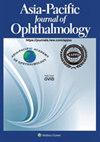年龄相关性黄斑变性生活质量信息库的心理测量评估和计算机自适应测试模拟。
IF 4.5
3区 医学
Q1 OPHTHALMOLOGY
引用次数: 0
摘要
目的:优化年龄相关性黄斑变性(AMD)生活质量(QoL)题库(IBs)的心理测量特性,并采用计算机自适应测试(CAT)模拟评估其性能。设计:横断面临床研究。方法:261例AMD患者在7个IBs内回答219项:活动限制(AL);照明(LT);流动性(MB);情感(EM);关注(CN);AMD Management (AM);和工作(WK),统称为“MacCAT”。每个IB的心理测量特性(如测量精度;项“适合”;差异项目功能(DIF)采用Rasch分析进行评估。使用CAT模拟确定“高”和“中等”测量精度所需的平均项目数。结果:261例参与者(平均年龄70.5±7.6岁)中,无AMD、早、中、晚AMD(好眼)者分别为69例(26.4%)、35例(13.4%)、80例(30.7%)、77例(29.5%)。AL, EM, CN和AM在折叠反应类别并删除不匹配和/或DIF项目后,总体上显示出良好的心理测量特性。尽管进行了类似的重组工作,但LT和MB的测量精度不理想,但由于其他方面的良好心理测量表现而保留了下来。由于无法解决的心理测量问题,WK没有被进一步考虑。所有IBs的靶向性都不是最佳的。在其余六个IB的CAT模拟中,每个IB所需的平均项目数从8 (AL)到13 (MB)不等,为中等测量精度,13 (AL)到19 (MB)为高测量精度。结论:6个IBs表现出可接受的心理测量特性和潜在的CAT效率,表明MacCAT提供了AMD及其相关治疗对生活质量影响的综合测量。需要在更大的临床队列中进行进一步的测试。本文章由计算机程序翻译,如有差异,请以英文原文为准。
Psychometric evaluation and computerized adaptive testing simulations of age-related macular degeneration quality of life item banks
Purpose
To optimize the psychometric properties of age-related macular degeneration (AMD) quality of life (QoL) item banks (IBs), and evaluate their performance using computerized adaptive testing (CAT) simulations.
Design
Cross-sectional, clinical study.
Methods
261 AMD patients answered 219 items within seven IBs: Activity Limitation (AL); Lighting (LT); Mobility (MB); Emotional (EM); Concerns (CN); AMD Management (AM); and Work (WK), referred to collectively as “MacCAT”. The psychometric properties of each IB (e.g. measurement precision; item “fit”; differential item functioning (DIF)) were assessed using Rasch analysis. The mean number of items required for “high” and “moderate” measurement precision was determined using CAT simulations.
Results
Of the 261 participants (mean age 70.5 ± 7.6 years), 69 (26.4 %), 35 (13.4 %), 80 (30.7 %) and 77 (29.5 %) had no, early, intermediate and late AMD (better eye), respectively. AL, EM, CN and AM displayed good psychometric properties overall after collapsing response categories and deleting items for misfit and/or DIF. Despite similar reengineering efforts, LT and MB had suboptimal measurement precision but were retained due to otherwise good psychometric performances. Owing to unresolvable psychometric issues, WK was not considered further. Targeting for all IBs was suboptimal. In CAT simulations on the six remaining IBs, the mean number of items required per IB ranged from 8 (AL) to 13 (MB) for moderate, and 13 (AL) to19 (MB) for high measurement precision.
Conclusions
Six IBs demonstrated acceptable psychometric properties and potential CAT efficiency, suggesting MacCAT provides a comprehensive measurement of the QoL impact of AMD and associated treatments. Further testing in larger clinical cohorts is needed.
求助全文
通过发布文献求助,成功后即可免费获取论文全文。
去求助
来源期刊

Asia-Pacific Journal of Ophthalmology
OPHTHALMOLOGY-
CiteScore
8.10
自引率
18.20%
发文量
197
审稿时长
6 weeks
期刊介绍:
The Asia-Pacific Journal of Ophthalmology, a bimonthly, peer-reviewed online scientific publication, is an official publication of the Asia-Pacific Academy of Ophthalmology (APAO), a supranational organization which is committed to research, training, learning, publication and knowledge and skill transfers in ophthalmology and visual sciences. The Asia-Pacific Journal of Ophthalmology welcomes review articles on currently hot topics, original, previously unpublished manuscripts describing clinical investigations, clinical observations and clinically relevant laboratory investigations, as well as .perspectives containing personal viewpoints on topics with broad interests. Editorials are published by invitation only. Case reports are generally not considered. The Asia-Pacific Journal of Ophthalmology covers 16 subspecialties and is freely circulated among individual members of the APAO’s member societies, which amounts to a potential readership of over 50,000.
 求助内容:
求助内容: 应助结果提醒方式:
应助结果提醒方式:


